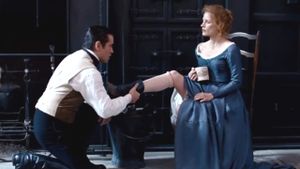Notes on Strindberg’s Miss Julie (1888)

I read this play in graduate school, and I’m surprised that it didn’t make more of an impression at that time. This is one odd play: it seems simultaneously realistic psychologically and surreal—like the illogic of a dream or in its constant shifts, it’s oppressive feel, and its sometimes heavy-handed symbolism. I guess that speaks of its naturalism: it does feel like a Zola novel in its rawness and the threat of the sinister lurking just under the surface. Here are a few random notes and observations.
An important symbol—if not the important symbol in Jean’s case—is delivered by Jean at the beginning of the play: the Count’s “high-top boots with spurs.”[1] They are placed in an obvious location, and remain throughout the play. The boots symbolize an oppressive, cruel, god-like presence that traps the characters in pre-determined roles. The boots are made for walking, and they figuratively keep the underlings downtrodden, protect the wearing from contact, and therefore allow the count to walk unscathed through all kinds of shit. Neither Julie, nor Jean—no matter the steps they take—can escape the influence of the count—even when he is not literally present.
The boots, too, foreshadow Jean’s kissing of Miss Julie’s shoe in an upcoming scene where she asserts control and dominance. The spurs also align with another symbol of cruelty and control: Miss Julie’s whip.
. . .
Citations
- ↑ Stringberg 2017, p. 121.
Work Cited
- Strindberg, August (2017) [1888]. "Miss Julie". In Gainor, J. Ellen; Garner Jr., Stanton B.; Puchner, Martin. The Norton Anthology of Drama. Volume 2 (Third ed.). New York: W. W. Norton & Company.
